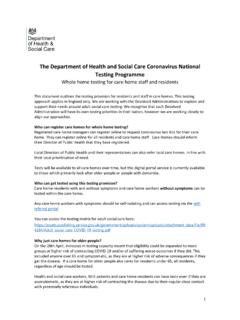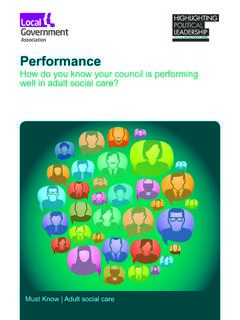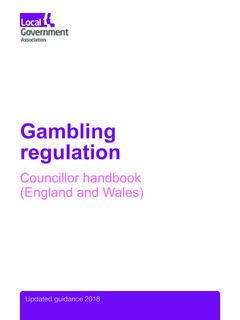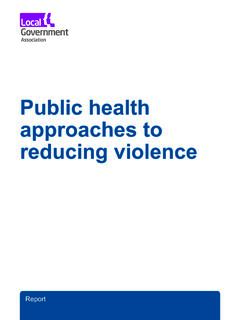Transcription of Contingency Planning Toolkit and Guidance
1 Contingency Planning Toolkit and Guidance Page 2 of 41 Contents Application of this Guide .. 3 The Context to Market Failure .. 3 Overview .. 3 Policy Context .. 4 Definitions .. 5 A Whole System Approach to Contingency Planning .. 6 Part 1: Setting up Contingency Plans .. 7 Embedding Contingency Planning into Day-to-Day Operations .. 7 Risk Assessment & Scenario Planning .. 8 Responsibility for Development and Ownership .. 13 Operating Principles .. 13 Market Insight and Information Sharing .. 14 Part 2: Dealing with Provider Failure .. 16 Trigger points and activation of the Contingency plan.
2 16 Roles & Responsibilities .. 17 Initial Response [QuickStart Checklist] .. 21 Identifying the Extent of the Problem and Options Appraisal .. 23 Scenario Plans .. 24 Continuity of Care .. 24 Communications .. 24 Lessons Learned .. 28 Appendix 1: Contingency Plan Template .. 30 Appendix 2: Source Information & NW Contingency Plan Examples .. 31 Appendix 3: Market Failure Case Studies .. 32 Appendix 4: Example Scenario Plans .. 34 Version Control Version Date Description 01/07/2019 Initial report draft 23/07/2019 Revisions and 09/08/2019 Draft shared with NW ADASS Programme Office 27/08/2019 Revisions following feedback FINAL 09/09/2019 Final revisions following feedback Page 3 of 41 Application of this Guide Whilst the principles of Contingency Planning apply to the broad range of care, this guide has been developed with a focus on regulated provision, namely: home care, residential and nursing homes and extra care housing.
3 And is formed of 2 key parts, these are: Part 1: Setting up Contingency Plans considers Contingency Planning as a whole system process and how this can be embedded into day-to-day operations, from the development of a specification through to evaluation, contract award and delivery. Part 2: Dealing with Provider Failure addresses the event of imminent critical market failure and enacting the Contingency Plan. Part 2 explores the contents of a Contingency plan in detail and a Contingency plan template is provided in Appendix 1. The processes and actions are not necessarily sequential and will depend upon the reason for the closure, the time available, and the level of cooperation of the provider.
4 Example scenario action plans are provided in Appendix 4 and should be read in conjunction with the guide. This guide has been developed utilising best practice from the region and national approaches. It is recognised that every situation is different and it is up to the responsible officer to decide the best approach for the given situation, interpreting this guide flexibly to suit the specifics of the local area and specific situation, while still being guided by its principles1. The Context to Market Failure Overview The impact of actual or prospective failure of a single provider imposes stress on a local care market, whereas the failure of a medium or large corporate Provider can present enormous challenges that may require the involvement of several public bodies.
5 Conversely, the National Audit Office s Managing Provider Failure (2015) identified: The failure of a provider is not necessarily something that should be avoided at all costs. It can be the necessary price of innovation or come from effective competition, keenly priced contracts and robust contract management. However, the failure of a provider can have serious consequences and departments must manage failure effectively, in order to ensure continuity of services, and to protect the interests of people who use them .2 Whilst the impact of provider failure can be severe, failures of care providers are relatively rare events, although occurrences have been more frequent in recent years.
6 On 5th November 2018, the CQC issued its first Stage 6 notification under the Market Oversight regime, this was in relation to the ongoing operation of services provided by Allied Healthcare. On the 29th March 2019 the North West branch of ADASS held a regional conference, Excellence in ensuring resilient markets and responding to provider failure , to share lessons learned from recent events and define future work programmes to 1 Business failure is tightly defined in the Care Act, to include only situations where the business has failed for financial reasons and the service is about to close.
7 The financial reasons cited in the Act include being declared insolvent or bankrupt. As local authorities have a responsibility for the safety of vulnerable individuals and preparation is similar, regardless of cause, this guide takes a broader approach to Contingency Planning beyond business failure. 2 National Audit Office s Managing Provider Failure (2015) identified, page 4. Page 4 of 41 prevent or minimise future impact of provider failure. Following the event, the branch surveyed the 23 NW local authorities and Contingency Planning was identified as an area for development. The recent ADASS Budget Survey 2019 identified the gravity of the situation.
8 The market is fragile and failing in some parts of the country. 72 directors say they have seen home care providers closing or ceasing to trade in the last six months (impacting on 7,019 people, more than double the number affected last year) and 38 directors had contracts handed back by home care providers (impacting on 3,464 people) in the same raising fees to providers, fees do not match what providers say they need to be sustainable. Directors biggest concern about the impact of savings made or planned is the prospect of providers facing financial difficulty and quality challenges. Policy Context Local authorities must be prepared to deal with the consequences of providers failing, exiting the market or being temporarily unable to provide services due to unforeseen events.
9 Section 48 of the Care Act 2014 requires that, if providers become unable to continue to deliver care to people because of business failure, Local Authorities must intervene and make arrangements for anyone affected so that their needs continue to be met. This includes all people using social care services, not just those whose care is funded by the Local Authority. In 2015 the Care and Support (Market Oversight) regulations were introduced, the gave the Care Quality Commission (CQC) responsibility for monitoring the financial health of larger providers whose failure could have devastating effects on a large number of people across several local authorities.
10 The criteria for entry are providers who, because of their size or concentration, Local Authorities would find difficult to replace were they to CQC will notify local authorities where it believes the whole of the regulated activity of a given provider on the scheme, is likely to fail. For example, if a single home owned by the provider is likely to fail because it is unprofitable, but the remainder of the provider s relevant regulated activity can continue. In these circumstances, it is the provider s responsibility to wind down and close the service in line with its contractual obligations and it is expected that providers would do so in a planned way that does not interrupt people s care.















